To many, a trip to Greece is all about the ancient city of Athens and the countless beautiful islands in the Aegean Sea. But if you shift your gaze to central Greece, you’ll find one of the country’s most spellbinding destinations, Meteora. Hidden among the mountains of Thessaly, Meteora is both naturally and historically fascinating, thanks to its unique rock formations and monasteries.
You’re in for a real treat if you visit Meteora – the improbable sight of ancient monasteries teetering on narrow pillars of rock. Follow these Meteora travel tips to make sure you don’t miss a thing.
A Brief Background on Meteora
To fully appreciate why Meteora is so special, you need a little context on what it is and how it came to be. Meteora is a place of unusual topography as well as an important historical and religious site. It’s the interplay of these features that make it such a unique destination.
Meteora is defined by a series of large rock pillars. These pillars give the area its name: “Meteora” roughly translates to “suspended in the air.” While some stand entirely on their own, others work with the ordinary hillside to form valleys, creating an unpredictable landscape.
This landscape alone would be a draw for tourists, but what really makes Meteora special is that the cliffs of many of these rocks are home to Greek Orthodox monasteries from the Middle Ages. Built in such a remote place to avoid the invading Turks, the monasteries themselves seem “suspended in the air.”
There were once two dozen monasteries across Meteora, but only six remain active. These six monasteries, along with their monks and nuns, are what visitors come to see in Meteora.

How to Get to Meteora
Positioned right in the middle of Greece, away from many of the country’s other major destinations, Meteora isn’t the most convenient place to reach. Although that may limit your options for how to travel to Meteora, it also makes the journey a little more straightforward, as you’re most likely to travel there from Athens or Thessaloniki.
Recommendation: If you don’t have much time in Greece, consider visiting Meteora on a guided day trip, such as this day tours from Athens or Thessaloniki.
To reach Meteora from Athens, you can take a regional train to the town of Kalabaka, which sits at the foot of the beautiful Meteora rocks. The direct train leaves from Athens once a day and makes the journey in less than five hours. There are also a few slower trains from both Athens and Thessaloniki that connect via Palaiofarsalos. You could also take the daily bus that connects Athens to Kalabaka and takes roughly the same time.
Of course, you could always rent a car and drive yourself to Meteora. This is not only the quickest option, but also allows you to shape your itinerary as you’d like. For the best rental prices, check out Rentalcars.com.

How To Get Around Meteora
How to Get Around Meteora
Since Meteora covers a surprisingly expansive area, it’s important for you to work out how you’ll get around there. The right option for you depends on how much time you have there and how you prefer to sightsee. For your first trip to Meteora, decide whether you’ll mainly get around by taking a tour, driving, or walking.
Taking a Tour
If you have limited time in the area and want to see the most important sights as easily as possible, a tour is the way to go. You have a huge selection of guided tours here, from a full-day tour of the monasteries to a four-hour tour that just shows you the best sunset spots. There are also activity tours for visitors interested in photography, food, or even rock climbing.
The two most popular tours are the Panoramic Meteora and Monasteries Tour and the Majestic Sunset Tour. The first is in the morning and the second in the evening, so you can join both of them on the same day to get the most out of your time in Meteora. You’ll get to visit all the monasteries and experience the incredible sunset from the famous Adrachti Pillar.
Driving
You’ll find roads winding around the wonderful landscape throughout Meteora. If you drive here, you can quickly get between each of the major monasteries without much hassle. Each monastery has its own parking lot, as do some of the scenic lookouts.
Hiking
While it’s the slowest way to see Meteora, hiking is the best way to see this part of Greece. Hiking trails starting at Kastraki and Kalabaka weave through the countryside up to each of the monasteries. They get quite steep, and you’ll occasionally need to follow the roadside, but you’ll see far more of Meteora on foot than you could any other way.
Recommendation: If you don’t feel confident enough to venture out on your own, consider this amazing five-hour hiking tour of Meteora.
Best Time to Visit Meteora
Time of year is one of the most important factors to consider when you’re planning a trip to Meteora. How you choose to get around and how much you like dealing with other tourists will determine the best time for you.
Located in the country’s mountainous center, Meteora is considerably cooler than Greece’s islands. That means it experiences milder summers than the south, so hiking around in the heat isn’t that bad. Still, summer is peak season for Greece, so the small monasteries can easily become crowded.
There are much fewer tourists in winter, when Meteora’s temperatures can drop below freezing. It’s also harder to find places to stay and eat, as many businesses close for the offseason.
As with many destinations, shoulder season (spring or fall) is a great time to visit Meteora. With more manageable tourist numbers, you won’t feel crowded and should find the weather comfortable. Even better is seeing the landscape of Meteora bursting with color, be it the blossoms of spring or the foliage of fall.
Where to Stay in Meteora
If you plan to stay in the region for a night or more, you should choose somewhere that gives you convenient access to the sights of Meteora as well as restaurants and other services.
Essentially, your choice of location comes down to two areas: the town of Kalabaka and the neighboring village of Kastraki. They sit at opposite sides of the main monasteries of Meteora, so you can drive or walk from either. It’s only about 2 kilometers from the center of one to the other, so it’s also easy to get between the two towns.
As the larger of the two, Kalabaka has more accommodations and restaurants, and it’s where both the bus and train arrive. Kastraki, on the other hand, is a small village with a quaint atmosphere. You’ll still find quite a few restaurants here and plenty of accommodation options, but you’ll have to make your way over from the bus or train station in Kalabaka.
For a resort-like setting, treat yourself to the four-star Divani Meteora Hotel in Kalabaka. With multiple pools and recreational facilities, attentive staff, and clean, stylish rooms, this grand hotel makes a great base for a Meteora visit.
A nice midrange option is Tsikeli Boutique Hotel. This beautiful three-star hotel has style in spades, not to mention views of the epic surrounding scenery. It’s in a quiet part of Kastraki but still not far from the heart of the village.
One of the few budget options around Meteora is The Holy Rock Hostel. This relatively new hostel offers the cheapest beds in Kalabaka, helpful staff, and great facilities such as a kitchen and common areas.
Where To Eat in Meteora
While there are no places to get food up by the monasteries, you’ll find a great selection of restaurants in Kalabaka and Kastraki. As the bigger town, Kalabaka offers a bit more variety than Kastraki, which tends to stick to traditional Greek restaurants.
In either town, you can expect plenty of Greek staples, such as grilled meats, saganaki appetizers, salads, and abundant vegetables. All of this goes best with Greek wine, including some local varieties.
One great place to visit is Taverna Xarama, a traditional Greek restaurant halfway between Kastraki and Kalabaka. Not only is the food good, but you have a good chance of being serenaded with a guitar, courtesy of the family that owns the tavern. Another place to consider is Taverna Gardenia in the center of Kastraki, which has tasty souvlakis.
Guide to Hiking in Meteora
One of the best travel tips for Meteora is to hike if you can, as this allows you to see not only the monasteries, but also the landscape in its entirety. The monasteries feel way more remote when you hike up through the forest to reach them. You also get to see the beautiful features of the forest, from trickling streams to small viewpoints.

Hiking in Meteora generally means alternating between following the main road and taking trails through the forest to the monasteries. While the trails are steep at times, you don’t need to be a champion hiker to tackle them. To give yourself plenty of time to hike, you should plan to stay at least two days in Meteora.

The best route from Kalabaka starts at the northernmost point of town. The narrow dirt track takes you out past olive groves before you climb up to the Monastery of the Holy Trinity. If you start from Kastraki, you’ll take the main road leaving the village to the northeast, which will bring you to the Monastery of St. Nicholas of Anapafsas.
The hiking trails are pretty well outlined, though it’s not always clear as to exactly where they lead. To avoid getting lost, grab a map of Meteora, which most of the area’s hotels and tour operators give away for free. Some places provide more detailed hiking maps, but you’ll need to pay for them, and they may not be necessary. Another option is to download maps onto your phone, ensuring you’ll always know where you are.

Best Things to Do in Meteora
No travel tips for visiting Meteora are complete without talking about each of the six active monasteries, the area’s main focus. Sure, there are some other landmarks and sights, but you come to Meteora to see the monasteries and how they fit into this remarkable landscape. The other things to do here are really just cherries on top for those who have a little extra time.
How much time you should give yourself in Meteora depends largely on how you’ll get around. If you take a guided tour or drive yourself, you could see all the highlights in one day. Hiking is best done over two days, though, so that you aren’t rushed and can explore a little further.
You’ll need to pay an entrance fee of €3 (about $3.28) per adult – anyone older than 12 – at each of the main monasteries. While this small price is well worth it, you might want to pick only a few to enter if you have a big group and a tight budget or little time. We’ve covered the main six (and then some) here to help you decide whether to explore them all.
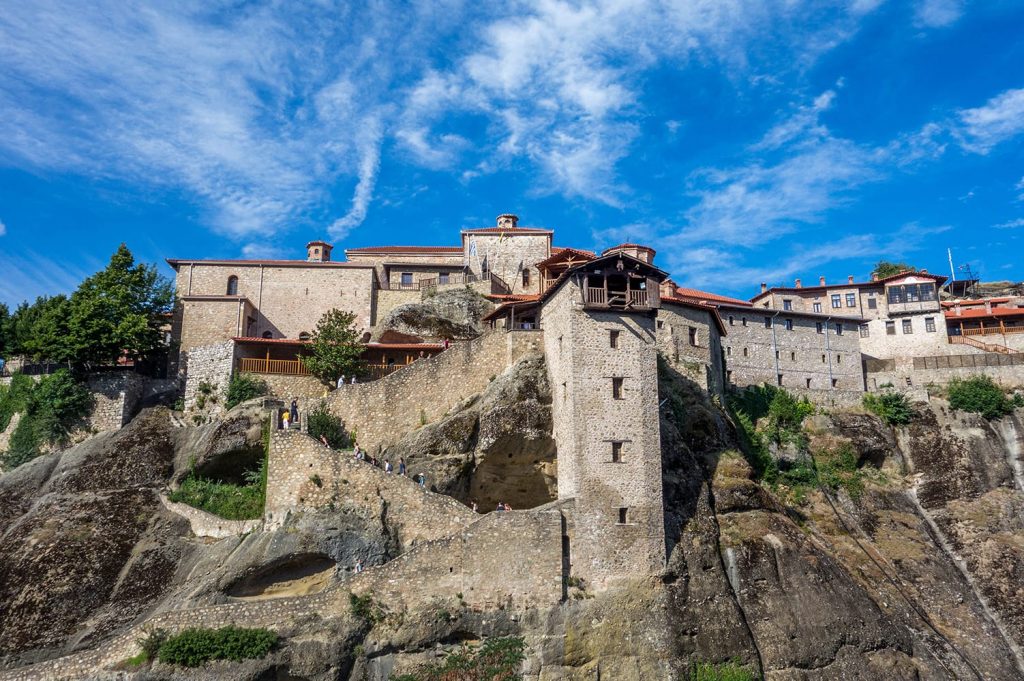
Monastery of Great Meteoron
As the oldest and largest of the Meteora monasteries, the Monastery of Great Meteoron is an impressive sight. Though it doesn’t sit quite as precariously as the other monasteries, its stone ribbon of stairs and countless buildings make it seem more like a fortified village than a monastery.
Inside this 14th-century monastery, you’ll be treated not only to views of Meteora, but also to gilded frescoes of saints and a museum on Meteora’s history. The museum is a great place to start your Meteora visit, as it provides some context on the places you’ll be visiting.

Monastery of Varlaam
Not far from Great Meteoron is the next-largest monastery, Varlaam. Built in the 16th century, this wonderfully preserved monastery is almost like a palace with its pristine architecture. It houses a church, refectory, and chapels full of religious icons, not to mention the most monks of any of the Meteora monasteries.
Monastery of Rousanou
Sitting roughly in the middle of the monasteries, Rousanou is Meteora’s most photographed monastery. This is because it stands out the most against the landscape, being perched on a cliff that’s visible from most other parts of Meteora. After sustaining significant damage in World War II, the monastery was rebuilt and is now an active convent.

Monastery of St. Nicholas of Anapafsas
Likely the lowest-lying monastery of the main six, the Monastery of St. Nicholas of Anapafsas looks almost like it grew from the stone pillar it sits upon. It’s hard to see where the rock ends and the monastery begins. Inside is an ornate chapel (which doesn’t allow photography, sadly), a little bell tower, and a rooftop viewing terrace, which really only has views of Kastraki and the Monastery of Rousanou due to its low vantage point.
Monastery of the Holy Trinity
The most isolated and hardest to reach of the Meteora monasteries is the Monastery of the Holy Trinity, which sits alone on a stone island and requires a climb up 140 stairs to enter it. This monastery has received multiple renovations over the years, but it remains pristinely picturesque with awesome views out over Kalabaka. In fact, it was a filming location for the 1981 James Bond movie For Your Eyes Only.
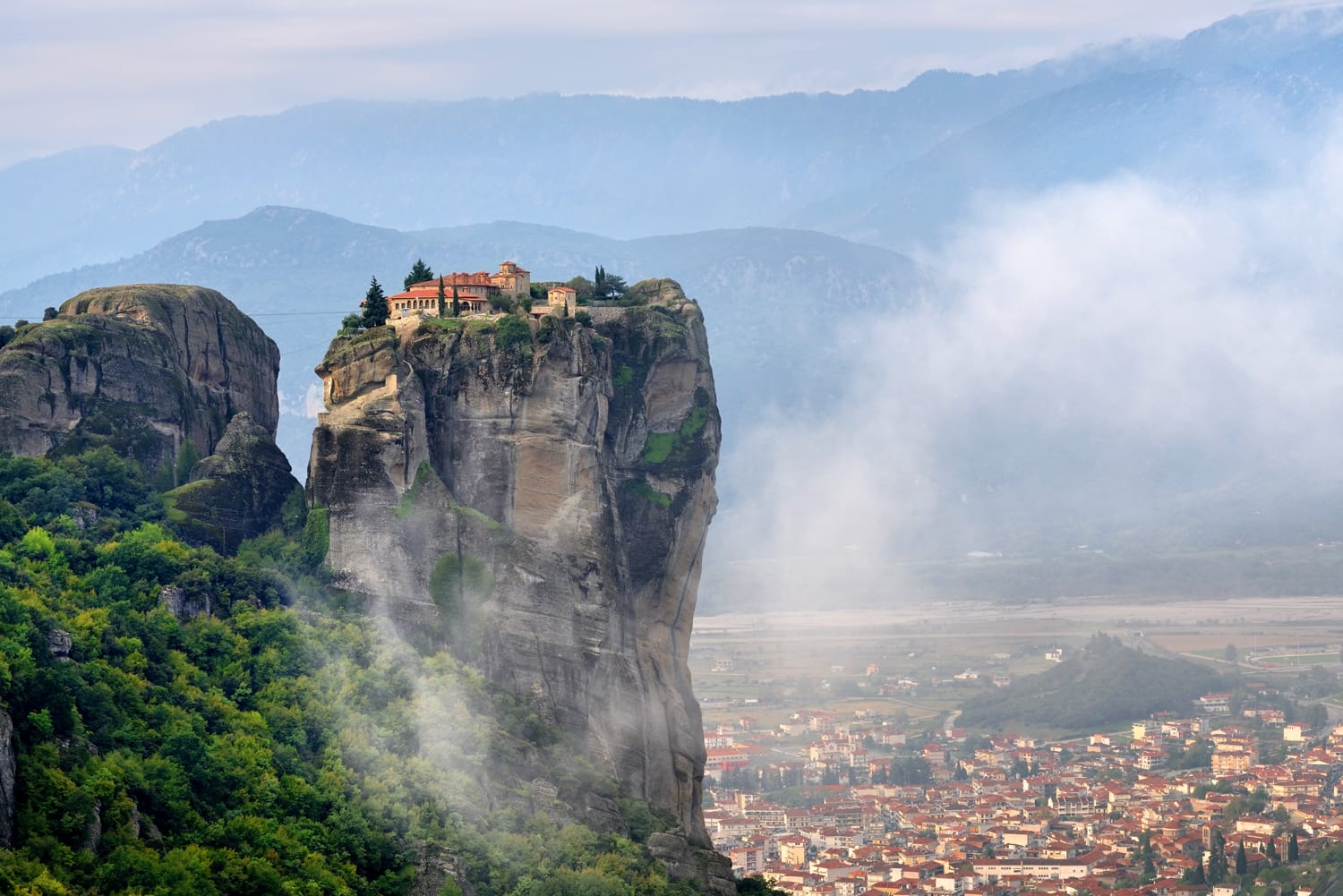
Monastery of St. Stephen
Just across a valley from the Monastery of the Holy Trinity lies the last of the big six, the Monastery of St. Stephen. This is the most accessible monastery in Meteora, with no stairs necessary to reach it. In the main chapel and cathedral, you can find lingering reminders of the damage inflicted during the Greek Civil War on this now-convent.
Other Monasteries and Rock Formations
Across the landscape of Meteora, you’ll likely see the ruins of several other monasteries. They aren’t really accessible today and are generally far away from the famous ones. For example, the Monastery of Ypapanti is closed to the public but still visibly wedged into the cliff face.
For a full panoramic view of Meteora, visit the scenic viewpoint roughly halfway between the Rousanou and Holy Trinity monasteries. With a small parking lot right off the main road, it’s easy to spot. Fitting all of Meteora’s splendor into a single shot is tricky, but this lookout gives you your best chance.
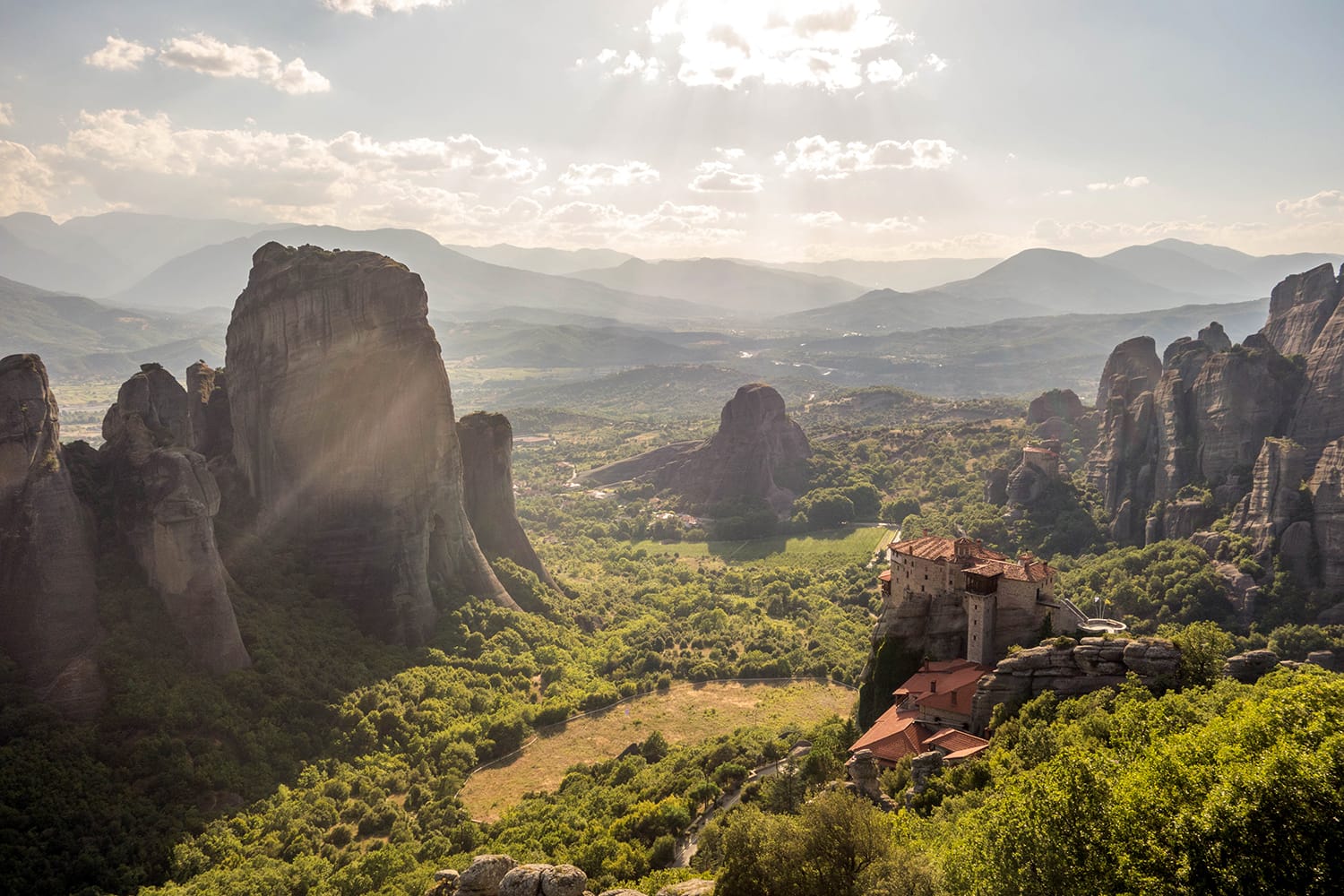
Another place to go to admire the rocks and boulders of Meteora is the Adrachti Pillar between Kastraki and Kalabaka, one of Meteora’s skinniest rocks. Surrounded by the hills of the region, it’s an atmospheric spot and easy to reach if you walk east out of Kastraki past the Byzantine Church of the Assumption of Virgin Mary.
That about does it for our tips for traveling to Meteora. You should now be amply prepared to visit this magical destination and fall further in love with Greece.

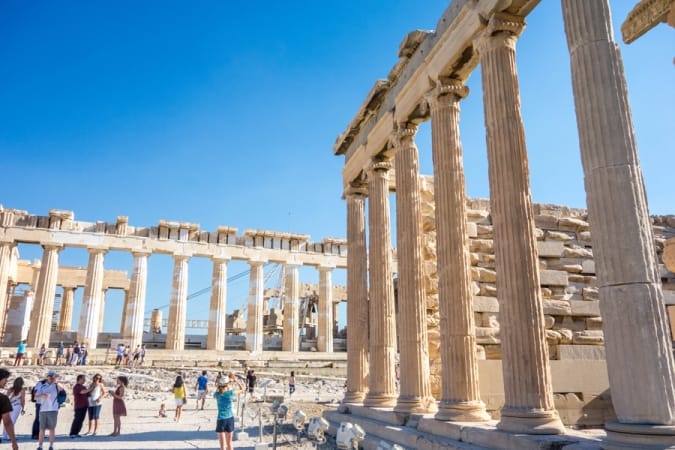

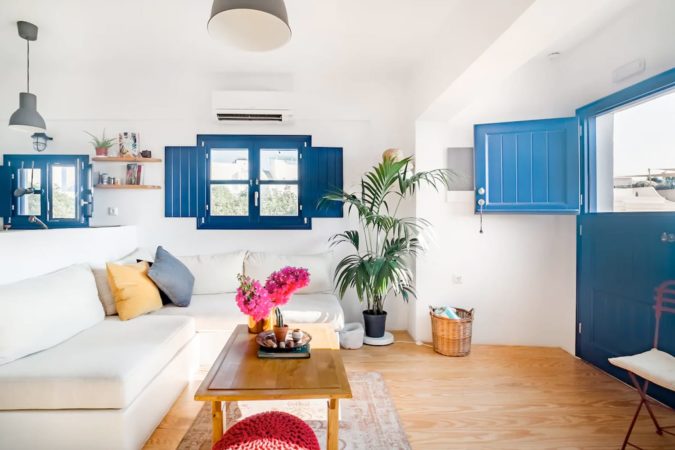

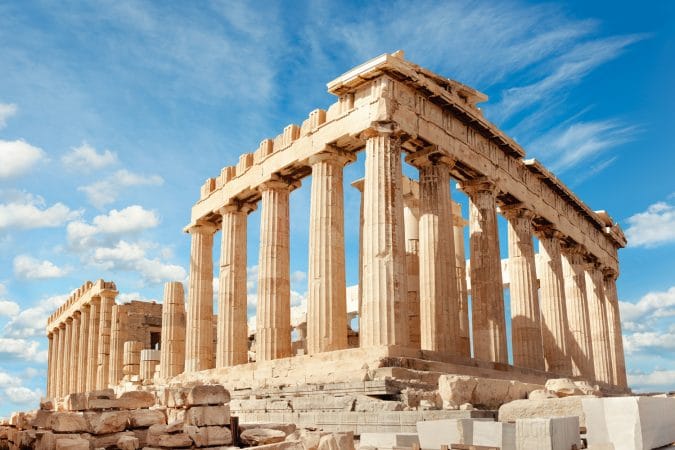
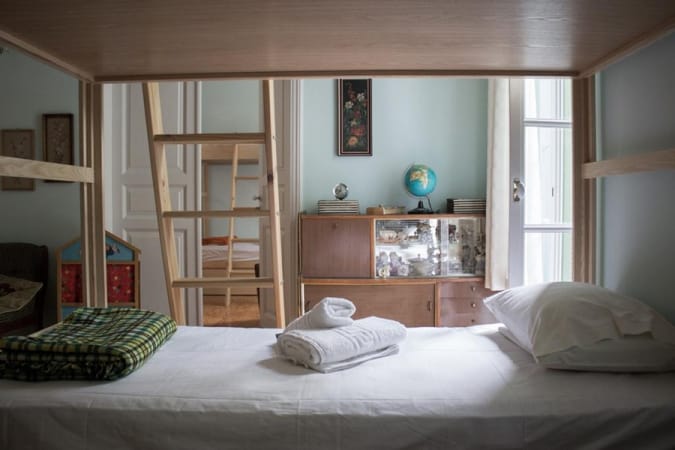
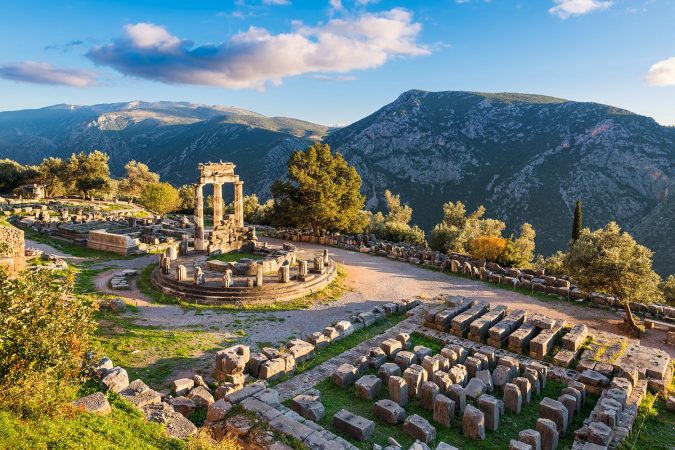
Konstantin
How feasible is it to get around the monasteries using the local bus from Kalambaka? It is supposed to depart from the KTEL bus station in Kalambaka and stop at all the monasteries. We have trouble walking long distances and are concerned abut finding parking spots with a rental car, so we were thinking of using either the bus or taxi to get from one monastery to another.
neha banik
hi , Im Neha,
two of my friends and i are travelling to meteora in the month of october, would like take pictures as you have posted that is from top of a hill. is it necessary to hike up the hill to take a picture or can we drive up to a hill?
Ben
Hey Neha. You can access Meteora by car, so there is no need to hike up :D